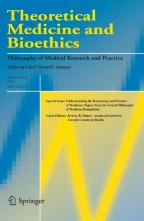450Accesses
43Citations
6Altmetric
Abstract
In the last two decades, prizes in the sciences have proliferated and, in particular, rich prizes with large honoraria. These developments raise several questions: Why have rich prizes proliferated? Have they greatly changed the reward system of science? What effects will such prizes have on scientists and on science? The proliferation of such prizes derives from marked limitations on the numbers and types of scientists eligible for Nobel prizes and consequent increases in the number of uncrowned laureate-equivalents. These would-be surrogates for Nobel prizes extend the reward system of science in its upper reaches but this change is not fundamental. The spread of rich prizes to new fields provides added incentives to potential winners, which has its own disutilities; it reinforces competitiveness, concern for priority and attendant secrecy, all this amplifying ambivalence toward the reward system in science. There may also be modest positive effects of such new awards in the form of heightened popular esteem for science and interest in it.
This is a preview of subscription content,log in via an institution to check access.
Access this article
Subscribe and save
- Get 10 units per month
- Download Article/Chapter or eBook
- 1 Unit = 1 Article or 1 Chapter
- Cancel anytime
Buy Now
Price includes VAT (Japan)
Instant access to the full article PDF.
Similar content being viewed by others
References
Gale Research Incorporated.Awards, Honors & Prizes. Detroit: Gale Research Inc, 1969.
Siegman G.Awards, Honors & Prizes. 9th ed. Vols 1 – 2. Detroit: Gale Research Inc, 1991.
Fiuggi Foundation for Culture.Rules for the Awarding of the Fiuggi International Prize. Rome, 1987.
Huler S. Why do societies take the trouble to give science prizes?The Scientist 1992 Feb 3:19, 24 (col 1).
Anderson A. The Japan Prize.Nature 1986;319:711.
Holden C. Kyoto Laureates.Science 1990;250:620.
Anonymous. Benjamin Franklin National Memorial, 1991 Bower Awards.The Scientist 1991 Feb 18: 7 (cols 2–5).
Pendlebury D. Billionaire Bren Funds UC-Irvine Program.The Scientist 1989 Aug 7:18.
Phillips K. Hot team: busy boss leads atmospheric chemistry group.The Scientist 1991 May 27:14 (col 1).
Anonymous. 3 win European biomed prize.The Scientist 1987:Nov 13: 25.
Crawford E.The Beginnings of the Nobel Institution. The Science Prizes, 1901–1915. Cambridge: Cambridge University Press, 1984.
Crawford E. The prize system of the Academy of Sciences, 1850–1914. In: Fox R, Weisz G, eds.The Organization of Science and Technology in France, 1808–1914. Paris: Maison des Sciences de l'Homme, 1980: 283–307
MacLeod R. Of medals and men: a reward system in Victorian science, 1826–1914.Notes and Records of the Royal Society of London 1971;26:81–105.
Merton RK.The Sociology of Science. Theoretical and Empirical Investigations. [Storer NW, ed] Chicago: The University of Chicago Press, 1973.
Gauja P.Les fondations de l'Académie des Sciences (1881–1915). Paris: Hendaye, 1917.
Nobel Foundation, ed.Nobel: The Man and His Prizes. 3rd ed. New York: American Elsevier Publishing Co, 1972.
Zuckerman H.Scientific Elite: Nobel Laureates in the United States. New York: Free Press, 1977.
Stigler GJ. Employment and compensation in education.National Bureau of Economic Research Occasional Paper 1950;(33).
National Science Foundation.Biennial PhD Survey, 1989. Washington, DC: National Science Foundation, 1991.
Crawford E.Nationalism and Internationalism in Science, 1880–1939: Four Studies of the Nobel Population. Cambridge: Cambridge University Press, 1992.
Teltsch K. Prize for religion will exceed $1 million in 1992.The New York Times 1991 Feb 1:10 (cols 2–5).
Teltsch K. Jersey monk wins Templeton Award.The New York Times 1987 Mar 8:C5.
Garfield G. Are the 1979 prizewinnersof Nobel class? In: Garfield G, ed.Essays of an Information Scientist. Vol 4. Philadelphia: ISI Press, 1981:609–17.
Zuckerman H. The sociology of the Nobel Prize: further notes and queries.American Scientist 1978; 66:420–5.
Royal Swedish Academy of Sciences.The Anna-Greta and Holger Crafoord Fund. Stockholm, nd:iii.
Davis M. Filling the Nobel gap.Discover 1981; (Jan):55.
Byrne G. NAE creates new prize.Science 1988;242:665.
Columbia University.Record 1978 Feb 28:1 (col 2).
Wade N. Dynamite prizes.Science 1979;204:487.
Anonymous.Harvard Magazine 1982; (Nov–Dec): 77.
Merton RK. The Matthew Effect in science. II: cumulative advantage and the symbolism of intellectual property.ISIS 1988;79:606–23.
Siekevitz P. On prizes.Science 1978;202:574
Anonymous. Seeker.The New York Times 1978 Nov 19:18E.
Cole JR, Cole S.Social Stratification in Science. Chicago: The University of Chicago Press, 1973.
Medawar PB.Advice to a Young Scientist. New York: Harper and Row, 1979.
Friedman RM. Nobel physics prize in perspective.Nature 1981;292:793–8.
Stigler GJ.Memoirs of an Unregulated Economist. New York: Basic Books, 1985.
Author information
Authors and Affiliations
Andrew W. Mellon Foundation and Columbia University, 140 East 62nd Street, 10021, New York, NY, USA
Harriet Zuckerman
- Harriet Zuckerman
You can also search for this author inPubMed Google Scholar
Rights and permissions
About this article
Cite this article
Zuckerman, H. The proliferation of prizes: Nobel complements and Nobel surrogates in the reward system of science.Theor Med Bioeth13, 217–231 (1992). https://doi.org/10.1007/BF02163629
Issue Date:
Share this article
Anyone you share the following link with will be able to read this content:
Sorry, a shareable link is not currently available for this article.
Provided by the Springer Nature SharedIt content-sharing initiative



